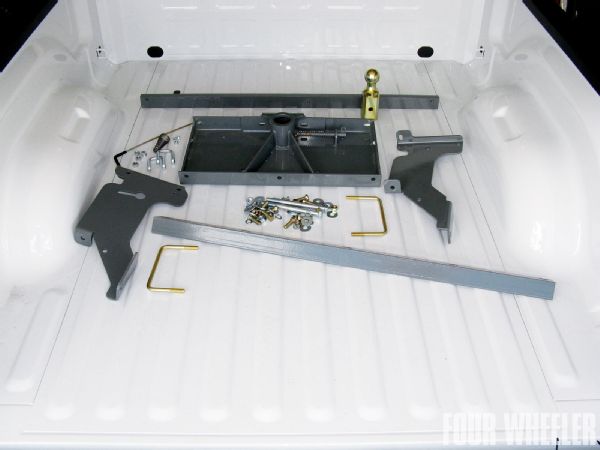
Correctly optioned, the 2010 Dodge Ram is already setup to tow some serious loads, complete with a factory receiver, the appropriate electrical trailer connections, and even a built-in brake controller. As long as it's a regular bumper-pull trailer, that is. Those with gooseneck or fifth-wheel trailers will have to add the necessary hardware, and there's no reason you couldn't do it yourself-well, with a little help from a friend at one point in the installation process it's more feasible, but still plenty doable in the driveway.
 This is a typical starting point: All the bits and pieces of a Turnover Ball hitch -- and a pristine pickup bed. Needless to say, it would be really stupid not to pay very close attention to the instructions and mark the bed accordingly before striking the center punch in preparation for drilling the first, and largest, hole.
This is a typical starting point: All the bits and pieces of a Turnover Ball hitch -- and a pristine pickup bed. Needless to say, it would be really stupid not to pay very close attention to the instructions and mark the bed accordingly before striking the center punch in preparation for drilling the first, and largest, hole.
There are several gooseneck hitches to choose from, and one very popular version is the Turnover Ball by B&W. This patented hitch has a distinct advantage over the competition in that the base for the removable trailer ball is square. No big deal? Well, for one, it effectively prevents the ball from turning in the base instead of the coupler turning on the ball, so there should be less wear on the permanently installed hardware. Also, notice that we said "gooseneck/fifth-wheel" earlier. Those are obviously two completely different setups, but the square design allowed B&W's engineers to come up with the Companion Hitch-a fifth-wheel that drops into the same hole as the ball, with no other attachments needed. In other words, you can have a flat and fully usable bed as before, or the gooseneck ball installed upright, or a fifth wheel-all using the same underbed hardware, and in the case of a 2003-10 Dodge Ram 2500 or 3500, that hardware is Model 1306R. That companion hitch is quite a nice piece in itself, but that's another story.
Following are some of the highlights of a Turnover Ball hitch installation, which took way longer than the one hour mentioned on B&W's website, partially because of working alone and trying the virtually impossible, partially due to using only hand tools, except for a cordless drill motor.
PhotosView Slideshow










